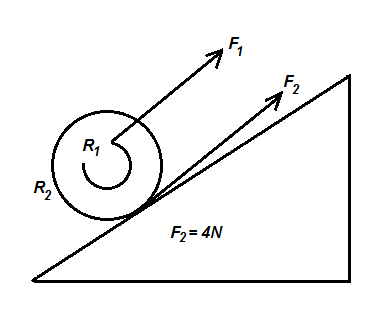
Answer
461.1k+ views
Hint: First of all, we will find the individual torques for the two different forces. After that we will equate both the equations as the net torque is zero for a body moving at constant speed. We will manipulate accordingly and obtain the result.
Complete step by step answer:
In the given problem, we are supplied with the following data:
The frictional force of ground pushing the rear wheel is the frictional force of ground pushing the rear wheel is \[4\,{\text{N}}\] .
The radius of the rear socket wheel is \[30\,{\text{cm}}\] .
The radius of the front socket wheel is \[4\,{\text{cm}}\] .
We are asked to find the force \[{F_1}\] , with which the chain pulls on the socket wheel.
To begin with, we have to know that this problem is based on the rolling motion. Again, we can observe that the bicycle is moving up the inclined plane with a speed which is constant. This can be used to use the net force and the net torque is also zero.
First case:
The torque developed due to the force \[{F_1}\] can be expressed with the equation:
\[{\tau _1} = {r_1} \times {F_1}\] …… (1)
Where,
\[{\tau _1}\] indicates the torque developed by the force.
\[{r_1}\] indicates the radius of the smaller socket wheel.
\[{F_1}\] indicates the force with which the chain pulls on the socket wheel.
Second case:
The torque developed due to the force \[{F_2}\] can be expressed with the equation:
\[{\tau _2} = {r_2} \times {F_2}\] …… (2)
Where,
\[{\tau _2}\] indicates the torque developed by the force.
\[{r_2}\] indicates the radius of the smaller socket wheel.
\[{F_2}\] indicates the frictional force.
Since, the net torque is zero, we can write:
\[{\tau _1} = {\tau _2} \\
{r_1} \times {F_1} = {r_2} \times {F_2} \\
\]
\[{F_1} = \dfrac{{{r_2} \times {F_2}}}{{{r_1}}}\] …… (3)
Substituting the required values in the equation (3), we get:
\[
{F_1} = \dfrac{{30 \times 4}}{5} \\
{F_1} = 24\,{\text{N}} \\
\]
Hence, the force with which the chain pulls on the socket wheel is \[24\,{\text{N}}\] .
The correct option is B.
Note:It is important to note that if a rotatable object has a net torque of zero, it will be in rotational equilibrium and will not be able to obtain angular acceleration. Torque is therefore zero when the body is static.
Complete step by step answer:
In the given problem, we are supplied with the following data:
The frictional force of ground pushing the rear wheel is the frictional force of ground pushing the rear wheel is \[4\,{\text{N}}\] .
The radius of the rear socket wheel is \[30\,{\text{cm}}\] .
The radius of the front socket wheel is \[4\,{\text{cm}}\] .
We are asked to find the force \[{F_1}\] , with which the chain pulls on the socket wheel.
To begin with, we have to know that this problem is based on the rolling motion. Again, we can observe that the bicycle is moving up the inclined plane with a speed which is constant. This can be used to use the net force and the net torque is also zero.
First case:
The torque developed due to the force \[{F_1}\] can be expressed with the equation:
\[{\tau _1} = {r_1} \times {F_1}\] …… (1)
Where,
\[{\tau _1}\] indicates the torque developed by the force.
\[{r_1}\] indicates the radius of the smaller socket wheel.
\[{F_1}\] indicates the force with which the chain pulls on the socket wheel.
Second case:
The torque developed due to the force \[{F_2}\] can be expressed with the equation:
\[{\tau _2} = {r_2} \times {F_2}\] …… (2)
Where,
\[{\tau _2}\] indicates the torque developed by the force.
\[{r_2}\] indicates the radius of the smaller socket wheel.
\[{F_2}\] indicates the frictional force.
Since, the net torque is zero, we can write:
\[{\tau _1} = {\tau _2} \\
{r_1} \times {F_1} = {r_2} \times {F_2} \\
\]
\[{F_1} = \dfrac{{{r_2} \times {F_2}}}{{{r_1}}}\] …… (3)
Substituting the required values in the equation (3), we get:
\[
{F_1} = \dfrac{{30 \times 4}}{5} \\
{F_1} = 24\,{\text{N}} \\
\]
Hence, the force with which the chain pulls on the socket wheel is \[24\,{\text{N}}\] .
The correct option is B.
Note:It is important to note that if a rotatable object has a net torque of zero, it will be in rotational equilibrium and will not be able to obtain angular acceleration. Torque is therefore zero when the body is static.
Recently Updated Pages
Fill in the blanks with suitable prepositions Break class 10 english CBSE

Fill in the blanks with suitable articles Tribune is class 10 english CBSE

Rearrange the following words and phrases to form a class 10 english CBSE

Select the opposite of the given word Permit aGive class 10 english CBSE

Fill in the blank with the most appropriate option class 10 english CBSE

Some places have oneline notices Which option is a class 10 english CBSE

Trending doubts
Fill the blanks with the suitable prepositions 1 The class 9 english CBSE

How do you graph the function fx 4x class 9 maths CBSE

When was Karauli Praja Mandal established 11934 21936 class 10 social science CBSE

Which are the Top 10 Largest Countries of the World?

What is the definite integral of zero a constant b class 12 maths CBSE

Why is steel more elastic than rubber class 11 physics CBSE

Distinguish between the following Ferrous and nonferrous class 9 social science CBSE

The Equation xxx + 2 is Satisfied when x is Equal to Class 10 Maths

Differentiate between homogeneous and heterogeneous class 12 chemistry CBSE





